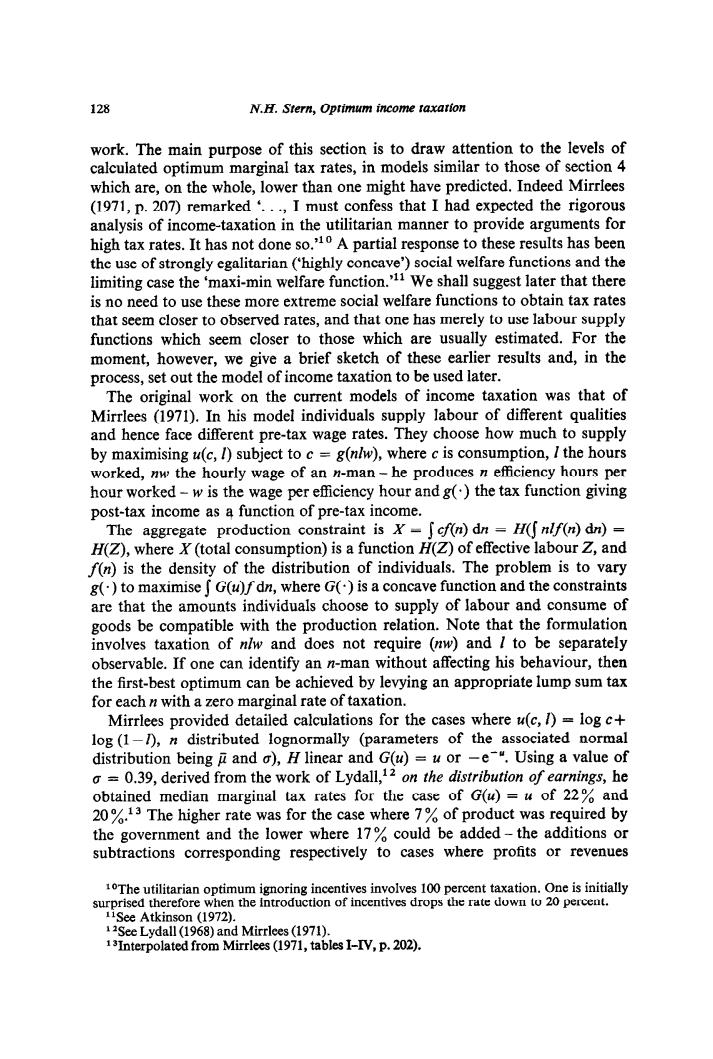正在加载图片...

128 N.H.Stern,Optimum income taxation d op te rginal ta which are,on the wh lower than one might h ve pr edicted Indeed Mirrlee (1971,D.207)remarked I must confess that I had expe ted the rigorou analysis of income-taxation in the utilitarian manner to provide arguments for high tax rates.It has not done so."10 A partial response to these results has been the use of strongly egalitarian('highly concave')social welfare functions and the limiting case the 'maxi-min welfare function.'1 We shall suggest later that there is no need to use these more extreme social welfare functions to obtain tax rates that se closer to obse and that one has m erely to use labour supply functio seem ose to those which ar ally estimated for the moment,however,we give a brief sketch results and. in the process,set out the model of income taxat The original work on the current models of income taxation was that of Mirrlees (1971).In his model individuals supply labour of different qualities and hence face different pre-tax wage rates.They choose how much to supply by maximising u(c.D)subject to c=g(nlw),where c is consumption,I the hours worked.nw the hourly wage of an n-man-he produces n efficiency hours per hour worked- v is the ag per effciency hou and g()the tax function giving -tax inc come as a fu on ol pre-t aggregate prod ction is (n)dn =H(S nlf(n)dn) H(Z),where X(total consumption)is a functi H(Z)of effecti 2,and f(n)is the density of the distribution of individuals.The problem is to vary g()to maximise f G(u)fdn,where G()is a concave function and the constraints are that the amounts individuals choose to supply of labour and consume of okeamettmhaeaoaoRoghenoanht。eocpehia identify an n-man without affecting his behaviour,then opti mum can levying an appropriate lu ump sum ta for each n with a ze ma Mirrlees provided detaile d calculations for the case here u(c,1) =log c+ log(1-D),n distributed lognormally (parameters of the ass iated norma distribution being i and a),H linear and G(u)=u or -e".Using a value of =0.39,derived from the work of Lydall,12 on the distribution of earnings,he obtained median marginal tax rates for the case of G(u)=u of 22%and 2013 The higher rate was for the case where 7%of product was required by the me and the lower where 17%could be added-the additions or rresponding respe ctively to ases where profits or revenues 100 ent taxation.One is initially surpr 1073 See Lydall (1968)and Mirrlees(1971) Interpolated from Mirrlees (1971,table es I-IV,p.202) 128 N.H. Stern, Optimum income luxation work. The main purpose of this section is to draw attention to the levels of calculated optimum marginal tax rates, in models similar to those of section 4 which are, on the whole, lower than one might have predicted. Indeed Mirrlees (1971, p. 207) remarked ‘. . ., I must confess that I had expected the rigorous analysis of income-taxation in the utilitarian manner to provide arguments for high tax rates. It has not done ~0.‘~’ A partial response to these results has been the use of strongly egalitarian (‘highly concave’) social welfare functions and the limiting case the ‘maxi-min welfare function.‘” We shall suggest later that there is no need to use these more extreme social welfare functions to obtain tax rates that seem closer to observed rates, and that one has merely to use labour supply functions which seem closer to those which are usually estimated. For the moment, however, we give a brief sketch of these earlier results and, in the process, set out the model of income taxation to be used later. The original work on the current models of income taxation was that of Mirrlees (1971). In his model individuals supply labour of different qualities and hence face different pre-tax wage rates. They choose how much to supply by maximising u(c, I) subject to c = g(nlw), where c is consumption, I the hours worked, nw the hourly wage of an n-man - he produces n efficiency hours per hour worked - w is the wage per efficiency hour and g( a) the tax function giving post-tax income as q function of pre-tax income. The aggregate production constraint is X = J cf(n) dn = H(J n&z) dn) = H(Z), where X (total consumption) is a function H(Z) of effective labour 2, and f(n) is the density of the distribution of individuals. The problem is to vary g( .) to maximise J G(u)f dn, where G(a) is a concave function and the constraints are that the amounts individuals choose to supply of Iabour and consume of goods be compatible with the production relation. Note that the formulation involves taxation of nlw and does not require (nw) and I to be separately observable. If one can identify an n-man without affecting his behaviour, then the first-best optimum can be achieved by levying an appropriate lump sum tax for each n with a zero marginal rate of taxation. Mirrlees provided detailed calculations for the cases where u(c, I) = log c+ log (1 -I), n distributed lognormally (parameters of the associated normal distribution being F and a), H linear and G(u) = u or -e-“. Using a value of 0 = 0.39, derived from the work of Lydall,” on the distribution of earnings, he obtained median marginal tax rates for the case of G(u) = u of 22% and 20 “/ ’ 3 The higher rate was for the case where 7 y0 of product was required by the iovernment and the lower where 17 % could be added - the additions or subtractions corresponding respectively to cases where profits or revenues loThe utilitarian optimum ignoring incentives involves 100 percent taxation. One is initially surprised therefore when the introduction of incentives drops the rate down to 20 percent. %ke Atkinson (1972). ‘?3ee Lydall(l968) and Mirrlees (1971). 131nterpolated from Mirrlees (1971, tables I-IV, p. 202)